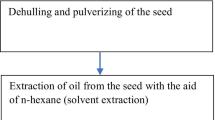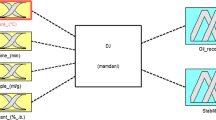Abstract
Vegetable oils are a very important feedstock for many industries such as biofuels. There is the need to source for novel and underexploited plant oilseeds to meet the world demand for oils. Thus, the extraction of oil from Hura crepitans (sandbox) seeds was conducted using the solvent extraction method. Modeling of the extraction process was carried out using response surface methodology (RSM) and adaptive neuro-fuzzy inference system (ANFIS). The effects of the nature of the solvent (non-polar (n-hexane) and polar (acetone and ethyl acetate)), solid-solvent ratio (0.1–0.3 g/mL), extraction time (2–6 h), and their interactions on the oil yield were investigated using the D-optimal design technique. Performance assessment of the developed models was carried out to check their effectiveness in predicting the H. crepitans seed oil (HCSO) yield using various fit statistics. The coefficient of determination (R2) observed for the RSM and ANFIS models was 0.9720 and 0.9988, respectively, with corresponding mean relative percent deviation (MRPD) of 2.50 and 0.37%. Maximum HCSO yield of 62.95 wt% was achieved by ANFIS coupled with genetic algorithm (GA) using 0.1 g/mL solid-solvent ratio, extraction time of 4.19 h, and acetone, while maximum HCSO yield of 62.50 wt% was observed by RSM with a solid-solvent ratio of 0.1 g/mL, extraction time of 4.04 h, and acetone. Characteristics of the HCSO indicated that it could serve as a good feedstock for the production of oleochemicals such as biodiesel. The results obtained in this study demonstrated that ANFIS is marginally superior to RSM in the modeling of the HCSO extraction process, while GA was slightly better than the numerical tool of RSM in the optimization of the process.









Similar content being viewed by others
Data availability
All data used in this work have been made available.
Abbreviations
- A :
-
solid-to-solvent ratio
- ANFIS:
-
adaptive neuro-fuzzy inference system
- B :
-
extraction time
- C :
-
solvent type
- CV:
-
coefficient of variance
- DoE:
-
design of experiments
- df:
-
degree of freedom
- GA:
-
genetic algorithm
- FT-IR:
-
Fourier transform infrared
- HCSO:
-
Hura crepitans seed oil
- MAE:
-
mean absolute error
- MRPD:
-
mean relative percent deviation
- MSE:
-
mean squared error
- R :
-
correlation coefficient
- R 2 :
-
coefficient of determination
- RMSE:
-
root mean square error
- RSM:
-
response surface methodology
- SEP:
-
standard error of prediction
- SD:
-
standard deviation
- SS:
-
sum of squares
References
Gary H (1983) Species accounts: Hura crepitans. Jabillo, Sandbox Tree
Ibrahim AP, Omilakin RO, Betiku E (2019) Optimization of microwave-assisted solvent extraction of non-edible sandbox (Hura crepitans) seed oil: a potential biodiesel feedstock. Renew Energy 141:349–358
Ezeh I, Umoren S, Essien E, Udoh A (2012) Studies on the utilization of Hura crepitans L. seed oil in the preparation of alkyd resins. Ind Crops Prods 36:94–99
Owolabi JB, Alabi KA, Lajide L (2015) Synthesis and characterization of copper metal soaps from Thevetia peruviana and Hura crepitans seed oils. Scientific Research and Essays 10:649–654
Adewuyi A, Göpfert A, Wolff T, Rao B, Prasad R (2012) Synthesis of azidohydrin from Hura crepitans seed oil: a renewable resource for oleochemical industry and sustainable development. ISRN organic chemistry 2012(873046). https://doi.org/10.5402/2012/873046
Adewuyi A, Gennaro A, Durante C (2015) Bioadsorbent Hura crepitans for the removal of phenol from solution. J Water Chem Technol 37:277–282
Adewuyi A, Awolade PO, Oderinde RA (2014) Hura crepitans seed oil: an alternative feedstock for biodiesel production. J Fuels 2014. https://doi.org/10.1155/2014/464590
Oyelade J, Idowu D, Oniya O, Ogunkunle O (2017) Optimization of biodiesel production from sandbox (Hura crepitans L.) seed oil using two different catalysts. Energy Sources Part A 39:1242–1249
Oraegbunam JC, Oladipo B, Falowo OA, Betiku E (2020) Clean sandbox (Hura crepitans) oil methyl esters synthesis: a kinetic and thermodynamic study through pH monitoring approach. Renew Energy 160:526–537
Ogbu IM, Ajiwe VIE, Okoli CP (2018) Performance evaluation of carbon-based heterogeneous acid catalyst derived from Hura crepitans seed pod for esterification of high ffa vegetable oil. BioEnergy Research 11:772–783
Oladipo B, Betiku E (2019) Process optimization of solvent extraction of seed oil from Moringa oleifera: an appraisal of quantitative and qualitative process variables on oil quality using D-optimal design. Biocatalysis and Agricultural Biotechnology 20:101187
Jisieike CF, Betiku E (2020) Rubber seed oil extraction: effects of solvent polarity, extraction time and solid-solvent ratio on its yield and quality. Biocatalysis and Agricultural Biotechnology 24:101522
Sorin-Stefan B, Ionescu M, Voicu G, Ungureanu N, Vladut V (2013) Calculus elements for mechanical presses in oil industry. Food Industry 1(8). https://doi.org/10.5772/53167
Okeleye AA, Betiku E (2019) Kariya (Hildegardia barteri) seed oil extraction: comparative evaluation of solvents, modeling, and optimization techniques. Chemical Eng Communs 206:1181–1198
Mueanmas C, Nikhom R, Petchkaew A, Iewkittayakorn J, Prasertsit K (2019) Extraction and esterification of waste coffee grounds oil as non-edible feedstock for biodiesel production. Renew Energy 133:1414–1425
Devi V, Khanam S (2019) Comparative study of different extraction processes for hemp (Cannabis sativa) seed oil considering physical, chemical and industrial-scale economic aspects. J Clean Prod 207:645–657
Fernandes SS, Tonato D, Mazutti MA, de Abreu BR, da Costa Cabrera D, D’Oca CDRM, Prentice-Hernández C, de las Mercedes Salas-Mellado M (2019) Yield and quality of chia oil extracted via different methods. J Food Eng 262:200–208
Al Juhaimi F, Uslu N, Babiker EE, Ghafoor K, Ahmed IAM, Özcan MM (2019) The effect of different solvent types and extraction methods on oil yields and fatty acid composition of safflower seed. J Oleo Science, ess19131. https://doi.org/10.5650/jos.ess19131
Mohammadpour H, Sadrameli SM, Eslami F, Asoodeh A (2019) Optimization of ultrasound-assisted extraction of Moringa peregrina oil with response surface methodology and comparison with Soxhlet method. Ind Crops Prods 131:106–116
Oniya O, Oyelade J, Ogunkunle O, Idowu D (2017) Optimization of solvent extraction of oil from sandbox kernels (Hura crepitans L.) by a response surface method. Energy and Policy Research 4:36–43
Betiku E, Odude VO, Ishola NB, Bamimore A, Osunleke AS, Okeleye AA (2016) Predictive capability evaluation of RSM, ANFIS and ANN: a case of reduction of high free fatty acid of palm kernel oil via esterification process. Energ Convers Manage 124:219–230
Mostafaei M, Javadikia H, Naderloo L (2016) Modeling the effects of ultrasound power and reactor dimension on the biodiesel production yield: comparison of prediction abilities between response surface methodology (RSM) and adaptive neuro-fuzzy inference system (ANFIS). Energy 115:626–636
Sajjadi B, Raman AAA, Parthasarathy R, Shamshirband S (2016) Sensitivity analysis of catalyzed-transesterification as a renewable and sustainable energy production system by adaptive neuro-fuzzy methodology. J Taiwan Inst Chem E 64:47–58
Aghbashlo M, Hosseinpour S, Tabatabaei M, Dadak A (2017) Fuzzy modeling and optimization of the synthesis of biodiesel from waste cooking oil (WCO) by a low power, high frequency piezo-ultrasonic reactor. Energy 132:65–78
Ishola NB, Adeyemi OO, Adesina AJ, Odude VO, Oyetunde OO, Okeleye AA, Soji-Adekunle AR, Betiku E (2017) Adaptive neuro-fuzzy inference system-genetic algorithm vs. response surface methodology: a case of ferric sulfate-catalyzed esterification of palm kernel oil. Process Saf Environ Prot 111:211–220
Ishola NB, Okeleye AA, Osunleke AS, Betiku E (2019) Process modeling and optimization of sorrel biodiesel synthesis usingbarium hydroxide as a base heterogeneous catalyst: appraisal of response surface methodology, neural network and neuro-fuzzy system. Neural Comput and Appl 31:4929–4943
Jang J-S, Sun C-T (1995) Neuro-fuzzy modeling and control. Proceedings of the IEEE 83:378–406
Lohani UC, Fallahi P, Muthukumarappan K (2015) Comparison of ethyl acetate with hexane for oil extraction from various oilseeds. J Am Oil Chem Soc 92:743–754
Tir R, Dutta PC, Badjah-Hadj-Ahmed AY (2012) Effect of the extraction solvent polarity on the sesame seeds oil composition. Eur J Lipid Sci Technol 114:1427–1438
Hron RJ Sr, Koltun SP, Graci AV Jr (1982) Biorenewable solvents for vegetable oil extraction. J Am Oil Chem Soc 59:674–682
Atkinson A, Donev A, Tobias R (2007) Optimum experimental designs, with SAS. New York
Ighose BO, Adeleke IA, Damos M, Junaid HA, Okpalaeke KE, Betiku E (2017) Optimization of biodiesel production from Thevetia peruviana seed oil by adaptive neuro-fuzzy inference system coupled with genetic algorithm and response surface methodology. Energ Convers Manage 132:231–240
Akintunde AM, Ajala SO, Betiku E (2015) Optimization of Bauhinia monandra seed oil extraction via artificial neural network and response surface methodology: a potential biofuel candidate. Ind Crops Prods 67:387–394
AOAC (1990) Official methods of analysis of the Association of Official Analytical Chemists. Official methods of analysis of the Association of Official Analytical Chemists, 15th edn. AOAC, Arlington, Virginia.
Demirbaş A (2008) Relationships derived from physical properties of vegetable oil and biodiesel fuels. Fuel 87:1743–1748
Krisnangkura K (1986) A simple method for estimation of cetane index of vegetable oil methyl esters. J Am Oil Chem Soc 63:552–553
Knothe G, Dunn RO (2003) Dependence of oil stability index of fatty compounds on their structure and concentration and presence of metals. J Am Oil Chem Soc 80:1021–1026
Joglekar A, May A (1987) Product excellence through design of experiments. Cereal Foods World 32:857–868
Myers RH, Montgomery DC, Anderson-Cook C (2009) Response surface methodology: product and process optimization using designed experiments. John Wiley & Sons, New York
Grčić I, Vujević D, Koprivanac N (2010) The use of D-optimal design to model the effects of process parameters on mineralization and discoloration kinetics of Fenton-type oxidation. Chem Eng J 157:408–419
Ajala SO, Betiku E (2015) Yellow oleander seed oil extraction modeling and process parameters optimization: performance evaluation of artificial neural network and response surface methodology. J Food Process Preserv 39:1466–1474
Betiku E, Ishola NB (2020) Optimization of sorrel oil biodiesel production by base heterogeneous catalyst from kola nut pod husk: neural intelligence-genetic algorithm versus neuro-fuzzy-genetic algorithm. Environmental Progress & Sustainable Energy 39:e13393
Attah JC, Ibemesi JA (1990) Solvent extraction of the oils of rubber, melon, pumpkin and oilbean Seeds. J Am Oil Chem Soc 67:25–27
Rubin LJ, Diosady LL, Phillips CR (1984) Solvent extraction of oil bearing seeds (United States Patent). Patent Number: 4460504. https://patentimages.storage.googleapis.com/61/62/7b/129ff887964272/US4460504.pdf. Accessed 30 June 2020
Chakrabarty M (2003) Chemistry and technology of oils & fats, vol 1. Allied Publishers
Acknowledgments
Authors wish to thank Mr. N. B. Ishola for technical assistance.
Author information
Authors and Affiliations
Contributions
Ropo Oluwasesan Omilakin: methodology, investigation, validation. Ayooluwa Paul Ibrahim: methodology, investigation, data curation, Software. Babajide Sotunde: data curation, writing—original draft. Eriola Betiku: conceptualization, supervision, project administration, writing—reviewing and editing.
Corresponding author
Ethics declarations
Conflict of interest
The authors declare that they have no conflict of interest.
Code availability
No code was generated in this work
Additional information
Publisher’s Note
Springer Nature remains neutral with regard to jurisdictional claims in published maps and institutional affiliations.
Electronic supplementary material
ESM 1
(DOCX 30 kb)
Rights and permissions
About this article
Cite this article
Omilakin, R.O., Ibrahim, A.P., Sotunde, B. et al. Process modeling of solvent extraction of oil from Hura crepitans seeds: adaptive neuro-fuzzy inference system versus response surface methodology. Biomass Conv. Bioref. 13, 247–260 (2023). https://doi.org/10.1007/s13399-020-01080-7
Received:
Revised:
Accepted:
Published:
Issue Date:
DOI: https://doi.org/10.1007/s13399-020-01080-7




